We all love to talk about our Favorite Things, but it’s not always the latest and greatest that charms us. Sometimes it’s those foundational favorites, the works that shaped us, that we find ourselves returning to again and again. Here at Speculative Chic, we decided it was way past time to create a dedicated platform to shine a spotlight on these longtime gems. Welcome to Blast from the Past.
Today we bring you science fiction author Albert Wendland, whose book of science fiction poetry, Temporary Planets for Transitory Days, comes out tomorrow, June 20th from Dog Star Books! But wait, there’s more! If you’d like to hear a live reading and interview from the Dr. Wendland himself, click here to register for tomorrow’s virtual launch party at 6:00 pm!
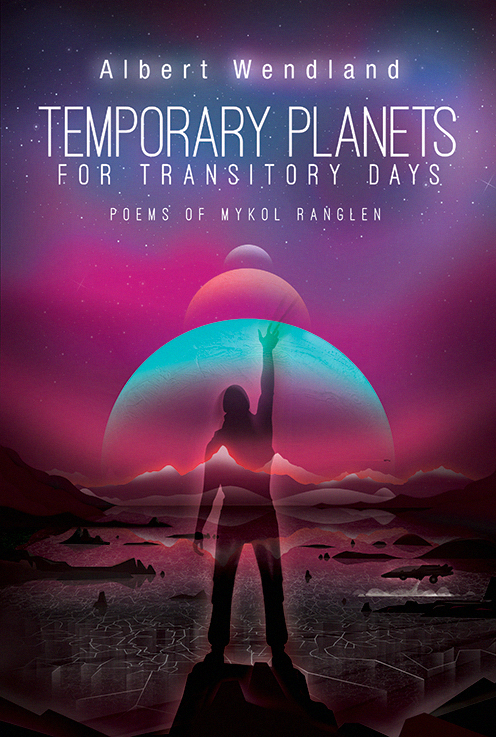
The Future (Dark), the Universe (Big), and the Fictions (Real): Noir, Outer Space, and Keeping the World Strange
I’m old enough that a blast from my past would go way back to the SF works of Andre Norton, Arthur Clarke, Clifford Simak, and the Uncle Scrooge comic books of Carl Barks. Or I could use another group from the more recent ’70s, like Ursula K. Le Guin, Phillippe Druillet, Valerian, and Gene Wolfe’s The Fifth Head of Cerberus. But, for this post, I won’t rock the cradle or dig so deeply into geological strata. Instead, let’s cover three examples — in film, prose, and graphic novels — from a more reachable time, and I’ll use them to generalize about some fascinating genres too: future noir, space opera, and the “secret history,” represented by the film Blade Runner, the two books Hyperion and The Fall of Hyperion, and the graphic novels Planetary.
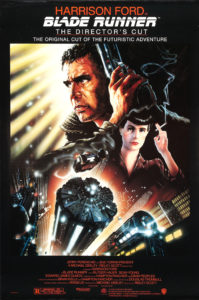 Prior to the year when Blade Runner came out (1982), there were two stories in the comics of the time that were harbingers of what was to come. Jim Starlin had written and illustrated a piece called “Darklon the Mystic” that appeared in Eerie magazine, a black-and-white large-sized comic that avoided the restrictions of the Comics Code. The magazine specialized in horror stories but occasionally included straight SF. This particular story was striking for its dark imagery, its seamy bars on nighttime planets, its grim tale of assassination and revenge, and its near 1940s film-noir mood of no exit, no help, no restraint, and no happy ending. (You can get a good summary of this mood in the last section of my poem “Loving the Spaceport” from Temporary Planets for Transitory Days, and the noir tone definitely influenced my first novel The Man Who Loved Alien Landscapes.)
Prior to the year when Blade Runner came out (1982), there were two stories in the comics of the time that were harbingers of what was to come. Jim Starlin had written and illustrated a piece called “Darklon the Mystic” that appeared in Eerie magazine, a black-and-white large-sized comic that avoided the restrictions of the Comics Code. The magazine specialized in horror stories but occasionally included straight SF. This particular story was striking for its dark imagery, its seamy bars on nighttime planets, its grim tale of assassination and revenge, and its near 1940s film-noir mood of no exit, no help, no restraint, and no happy ending. (You can get a good summary of this mood in the last section of my poem “Loving the Spaceport” from Temporary Planets for Transitory Days, and the noir tone definitely influenced my first novel The Man Who Loved Alien Landscapes.)
What astounded me about this story was that the future, up until then, was usually depicted as shiny, clean, almost squeaky bright and touched with awe. Of course, there had been plenty of post-apocalyptic stories, especially after-the-nuclear-war tales that were quite depressing, but they made up already a well-known SF sub-genre. What this story showed was so different to be almost startling — not apocalypse but a given, almost natural part of the future, the underside, the dark side. Future noir.
Then another story showed the mood even more graphically. Dan O’Bannon (who went on to write the script for the original Alien) wrote a story called The Long Tomorrow, illustrated by the French artist Moebius, which first appeared in the French magazine Metal Hurlant, then in the American version, Heavy Metal, the definitive place for innovative comic art back in that day. It showed a world-weary detective (straight out of Raymond Chandler and Dashiell Hammet) in a class-bound future city that was decrepit and grimy, its flying cars beat-up and rusty, its “mean streets” spotted with alien-life homeless, its plot vicious, its hero cruel, its values compromised, and its outcome dark.
Yet it was the future.
I loved it. I’m not sure if it touched a deep distrust in me about the glazed and attractive visions of futures past, but something profound did respond.
And then came Blade Runner.
And there was that same mood, but now high and wide up there on the big screen, with Vangelis music, Doug Trumbull’s special effects, Syd Mead’s visual designs, Harrison Ford’s cynical face, and a futuristic setting so dark and forbidding that all its brightly colored lights were near lost in smog, rain, and murky darkness.
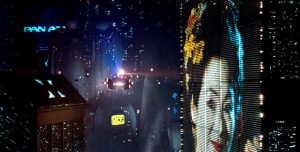
I saw the film about ten times over two weeks. Usually two showings for each visit.
It wasn’t the story that did it (a bit plodding). It wasn’t the characters (though the choice of actors was perfect for the parts). The themes were appealing — the replicants symbolized any disadvantaged and marginalized social group, with the cruel fate of having only a four-year life span, just to make sure they didn’t get out of line. And I loved the debate on what makes a human really human (as shown in the motto of the company that made the replicants, “More human than human.”) But these themes were still familiar from prose SF — the film was based, after all, on Philip K. Dick’s Do Androids Dream of Electric Sheep? What really knocked me over, then, was the ambiance, the worldbuilding (as we call it in SF), the “look,” and the perfect rendition of future noir. It was the movie I had longed for, dreamt about, before I even knew that I was doing so.
It blended perfectly hard-boiled detective fiction (world-weary protagonist, femme fatale, “innocent” love interest) with a futuristic setting (“replicants,” “spinners” or flying cars, the “Voight-Kampf empathy test,” acid rain, artificial animals, false memories). Almost every scene takes place at night in a rain-soaked Los Angeles (and how ironic to have a city known for its sunshine to be soaked in rain), where shops and diners gleam in multi-colored neon behind a wet saturated mist. All this amazed me. And the design! — the near Mayan decoration of Ford’s apartment, the ancient sepia photographs of his family, the grand interiors of the Bradbury building in downtown L.A., the random drift of searchlight beams playing among the dark urban structures like ghost ships in search of lost ports. And those haunting lines of dialogue. “It’s too bad she won’t live. But then again, who does?” Rutger Hauer’s dying speech (that he wrote himself): “All those memories will be lost in time, like tears, in rain. . . . Time to die.” An obscure line from William Blake was even quoted, that I’m sure no one but a teacher of British Literature would catch (like me).
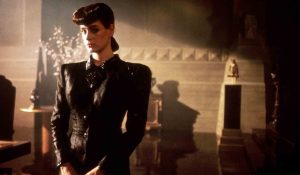
The film has become a cult classic, and much has been written about it by academic and cultural historians dealing with race, class, and society. Unfortunately, the film as a physical object is a little compromised itself since, when it was first released, a voice-over was imposed at the last minute (which Harrison Ford found so insulting to the film’s integrity he almost refused to record it), and a ridiculous happy ending added, using, of all things, outtakes from The Shining — it contradicted everything in the film up until then. There later was a Director’s Cut (which, by the way, the director, Ridley Scott, had little control over) that took out the voice-over and unlikely ending, and added a cut scene (which allowed us to see that the protagonist himself might be a replicant). Then, at last, there was a Final Cut (2007), which really was handled by Scott. But the print, in being “restored,” may have lost some of its original variety of color to make it look more gritty and somber. That might just be my imagination but I really felt a difference in appearance, alas.
Yet everything else is well-preserved. And the film is highly recommended for its near definitive rendition of noir futurism.
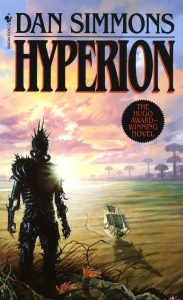 Next is Dan Simmons and his two novels, Hyperion and The Fall of Hyperion, which really are two parts of one novel. Space opera is a sub-genre of science fiction that takes place usually outside the solar system and out amid the stars. The term itself, a variant of “horse opera” (a put-down of westerns) was meant originally to denigrate some early SF (with swollen plots that left out characterization). But space opera had a great resurgence in the late 80s and 90s, and some of the best examples of SF (with strong characters and strong science) were published then by writers like C.J. Cherryh, Lois McMasters Bujold, Vernor Vinge, Iain M. Banks, Peter Hamilton, and Alastair Reynolds. The phrase is now lovingly applied to stories that are big and that take up a sizable chunk of the galaxy, with large-scale conflicts, high stakes, great adventure, huge time spans, and encounters with the cosmic sublime — a scale that threatens to go off the charts, with bigger excitements, more intense drama, and larger-than-life heroes and villains.
Next is Dan Simmons and his two novels, Hyperion and The Fall of Hyperion, which really are two parts of one novel. Space opera is a sub-genre of science fiction that takes place usually outside the solar system and out amid the stars. The term itself, a variant of “horse opera” (a put-down of westerns) was meant originally to denigrate some early SF (with swollen plots that left out characterization). But space opera had a great resurgence in the late 80s and 90s, and some of the best examples of SF (with strong characters and strong science) were published then by writers like C.J. Cherryh, Lois McMasters Bujold, Vernor Vinge, Iain M. Banks, Peter Hamilton, and Alastair Reynolds. The phrase is now lovingly applied to stories that are big and that take up a sizable chunk of the galaxy, with large-scale conflicts, high stakes, great adventure, huge time spans, and encounters with the cosmic sublime — a scale that threatens to go off the charts, with bigger excitements, more intense drama, and larger-than-life heroes and villains.
Dan Simmons has a reputation for writing in a variety of genres (horror, fantasy, mystery, historicals) and winning the “best-of-the-year” award in each genre he happens to write in. His most famous SF work is the pair of novels Hyperion (1989) and The Fall of Hyperion (1990). (A sequel duology, Endymion and The Rise of Endymion, came out in 1996-97, and collectively the four books are called the Hyperion Cantos.) They are full-color widescreen space operas that are very well-written, with rich creative poetic imagery and even allusions to famous literary works. Readers of John Keats will catch the reference in just the titles, but there also is a “cybrid,” an AI in a human body, of John Keats himself. And the first volume is structured like The Canterbury Tales: a group of travelers on a pilgrimage to a distant shrine decide to tell stories to occupy themselves.
But the destination of this pilgrimage is the science-fictional “Time Tombs” on the planet Hyperion, which is threatened with invasion from space. Each pilgrim intends to plead for help from a four-armed god-monster called the Shrike, a tall figure made of knives and razor-wire, who apparently lives in the Tombs and has a bad habit of impaling victims on a metal Tree of Pain.
By choosing that narrative structure, you get the feeling that Simmons isn’t just writing SF but celebrating it. He covers nearly every trope, sense of wonder, and classic variation of the genre in those tales, in personal revelations that eventually are connected to the overriding plot. We hear from a priest (who can live forever because of a “cruciform” on his back, an alien parasite shaped conveniently like a cross), a poet (who wrote an epic poem called “The Dying Earth” — Simmons’ reference to a classic SF novel — since Earth has vanished in a black hole), a soldier (who is now anti-militant and trying to stop the impending war), a scholar (whose daughter once was touched by the Shrike and is now growing backwards in time), a detective (who’s in love with the “Johnny” cybrid, and whose name is Brawne Lamia — more Keats references), and the consul, whose final story brings the many details of these flashbacks together, setting the stage for yet more conflict in the next volume. The first book ends with the pilgrims reaching the Tombs, whose doors then suddenly open.
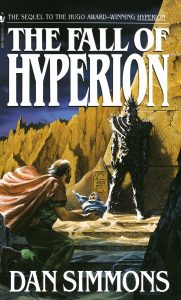 So, a cliffhanger. But The Fall of Hyperion picks up the bigger story, showing how the pilgrims’ tales fit into and eventually resolve the struggle that’s overwhelming human space. This coming war is among three main players: the Hegemony, or human civilization that is widespread but growing stagnant, the Ousters, a new culture that has adopted genetic change while living in treeships in outer space, and the TechnoCore, a communal AI working on an Ultimate Intelligence (or UI) and toying with a dangerous Void Which Binds. These groups do not get along well, their hidden alliances shift and change, and no one knows what the Shrike will do, since this walking assortment of dangerous cutlery can also control time.
So, a cliffhanger. But The Fall of Hyperion picks up the bigger story, showing how the pilgrims’ tales fit into and eventually resolve the struggle that’s overwhelming human space. This coming war is among three main players: the Hegemony, or human civilization that is widespread but growing stagnant, the Ousters, a new culture that has adopted genetic change while living in treeships in outer space, and the TechnoCore, a communal AI working on an Ultimate Intelligence (or UI) and toying with a dangerous Void Which Binds. These groups do not get along well, their hidden alliances shift and change, and no one knows what the Shrike will do, since this walking assortment of dangerous cutlery can also control time.
Scattered throughout the two novels are a large number of fascinating concepts: Tesla trees which electrocute passersby, underground tunnels that cut through a planet and come out the other side, anti-entropic force-fields that cause the Tombs to move backward in time, “farcasters” or teleportation portals through which a river can flow from planet to planet, and the kilometer-long treeships that live in their own globes of air and are used as both habitats and spaceships. The breadth of creativity, the variation in plots and characters, the wonders and terrors of this particular universe, are outstanding. And the requirements for space opera are all there: big conflicts, big situations, big losses, big stories. But what makes this space opera even better is Simmons’ great writing. He can be poetic, terse, eloquent, detailed, brutal, and moving, all at once. It’s no wonder he’s awarded in every genre he dabbles with. Indeed, to give just one quick example of evocativeness, here’s the opening sentence to Hyperion, one of my favorites:
The Hegemony Consul sat on the balcony of his ebony spaceship and played Rachmaninoff’s Prelude in C-sharp Minor on an ancient but well-maintained Steinway while great, green, saurian things surged and bellowed in the swamps below.
So much depicted, and suggested, in just one sentence.
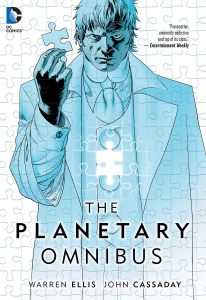 Last, Planetary, a collection of five graphic novels that collect 27 issues of a comic which ran from 1999 to 2009 (though available now in a single Omnibus edition), written by Warren Ellis and illustrated by John Cassaday. The series had some long publication gaps because of illness and Ellis’ insistence that only John Cassaday should illustrate it — much to the fans’ benefit, even if they got angry at the years of delay.
Last, Planetary, a collection of five graphic novels that collect 27 issues of a comic which ran from 1999 to 2009 (though available now in a single Omnibus edition), written by Warren Ellis and illustrated by John Cassaday. The series had some long publication gaps because of illness and Ellis’ insistence that only John Cassaday should illustrate it — much to the fans’ benefit, even if they got angry at the years of delay.
The series deals with the secret history of the twentieth century, what might have gone on behind the scenes that few people would know about (the genre’s like that of The X-Files). “Planetary” is a clandestine organization supporting an investigative field-team of three superpowered individuals: Drums (he communicates with machines), Jakita Wagner (a very strong female character with equivalent super-strength), and Elijah Snow (who can make things cold — he’s the brooding leader and main character, but he’s also struggling with amnesia). Their powers are somewhat irrelevant, though, since Ellis has said he didn’t want to write a superhero comic but a comic that was “about” superheroes, that treated popular culture as if its figures were “leaking” into the real world. And the uniqueness of the series is this self-referencing of its own genre’s creations.
Planetary sees itself as a band of “mystery archaeologists” whose task is to map that alternate history of the twentieth century. There’s an overall story arc of Elijah Snow investigating the reason for his amnesia and the team’s growing struggle with a group of supervillains called “the Four.” But the real focus to the agents’ unearthing of secrets is not to destroy them but to expose and understand their wonders, or — and this phrase gets repeated often — “to keep the world strange.” They want to celebrate the “depth of strangeness and beauty” that makes the world “a better place than advertised.” The villains instead impose mediocrity, enforce their selfish authority that works against a sense of amazement, of uplift or transcendence — the very awe that characters and scenes from popular culture would produce if they did exist. The Four, with superpowers themselves, try to keep all the riddles and hidden technologies to themselves, for their own private gain. But Planetary wants to give them to the world.
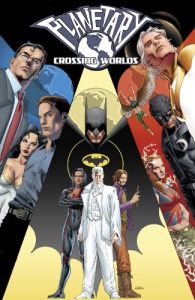 And the agents encounter remakes of such recognizable pop-culture figures as the Hulk, Doc Savage, Godzilla and Mothra, the Fantastic Four (they’re the villains, by the way — note how easily an open-topped “4” can be made into a swastika, and didn’t you ever wonder how much the world would advance if Mr. Fantastic would just share his many discoveries?), Marilyn Monroe, the giant ants of the ’50s scare-film Them, John Constantine (with cameo appearances from figures created by British comics-writers, like the Sandman, Death, Swamp Thing, and Animal Man), James Bond (or maybe Nick Fury — there’s argument for both), Superman, Wonder Woman, Green Lantern (the last three in a memorable story where they’re killed by the Four just prior to starting their careers — Superman is destroyed just as he arrives on Earth as a blanketed baby), the Lone Ranger, Tarzan, Hong Kong bullet movies, the Justice League, Thor’s hammer, and a collection of 19th century figures similar to Alan Moore’s League of Extraordinary Gentlemen — Frankenstein, the Invisible Man, Robur the Conqueror, Dracula, Sherlock Holmes, and H.G. Wells.
And the agents encounter remakes of such recognizable pop-culture figures as the Hulk, Doc Savage, Godzilla and Mothra, the Fantastic Four (they’re the villains, by the way — note how easily an open-topped “4” can be made into a swastika, and didn’t you ever wonder how much the world would advance if Mr. Fantastic would just share his many discoveries?), Marilyn Monroe, the giant ants of the ’50s scare-film Them, John Constantine (with cameo appearances from figures created by British comics-writers, like the Sandman, Death, Swamp Thing, and Animal Man), James Bond (or maybe Nick Fury — there’s argument for both), Superman, Wonder Woman, Green Lantern (the last three in a memorable story where they’re killed by the Four just prior to starting their careers — Superman is destroyed just as he arrives on Earth as a blanketed baby), the Lone Ranger, Tarzan, Hong Kong bullet movies, the Justice League, Thor’s hammer, and a collection of 19th century figures similar to Alan Moore’s League of Extraordinary Gentlemen — Frankenstein, the Invisible Man, Robur the Conqueror, Dracula, Sherlock Holmes, and H.G. Wells.
So the series is exuberantly post-modern and deconstructionist, meta-fiction about meta-humans, filled with self-references to its own origins, to the idea that popular culture might just be the epic of our times, the new great fiction for humanity. When the huge flying creatures from Japanese monster movies take to the air, one of the investigators declares, “Isn’t that great!” The stories suggest that all assumed truths are suspect, that we believe more in what we create than in what we encounter. With its outright use of lightly transformed pop-culture figures, it is gleefully self-conscious, drawing attention to its own “intertextual” nature (I’m borrowing catch-phrases from post-modernism here). Indeed, it even includes a story where a fictional world is created, called “Planet Fiction,” and then an expedition is sent there to bring back a living figure — which it does (though, mysteriously, we never learn who that figure is, and he’s very angry about being kidnapped into a “real” world). Even that real world, as the series goes on to show, is just one in a multiverse of realities — whose shape is like “a giant snowflake with 196,833 dimensions. “
We are all fictions now, and Planetary begins with that assumption, that we are popular fictions. And then it proceeds to create and play.
Or, as my favorite two lines of dialogue from the series say:
“It’s a strange world.”
“Let’s keep it that way.”
And, with works like the three covered here — about a redesigned future, big doings in the universe, and playfully fictional multiple realities — I believe we will.
 Albert Wendland has made a career out of his life-long interests in science fiction — and photography, art, film, and travel. He teaches writing and popular fiction at Seton Hill University, where he was director of its MFA in Writing Popular Fiction (the program famous for its exclusive attention to genre writing). His SF “space-noir” novel, The Man Who Loved Alien Landscapes, was a starred pick-of-the-week by Publisher’s Weekly, and a prequel, In a Suspect Universe, came out in 2018. A collection of poems, Temporary Planets for Transitory Days, supposedly written by the protagonist of both novels, will be released on June 20 of this year. He’s currently working on another “Mykol Ranglen” SF book, and another sequel is planned after that. He’s also published a study of science fiction, several articles on SF, and a chapter in the writing anthology Many Genres, One Craft. He’s interested in astronomy, geology, film, graphic novels, landscape photography, and “the sublime.”
Albert Wendland has made a career out of his life-long interests in science fiction — and photography, art, film, and travel. He teaches writing and popular fiction at Seton Hill University, where he was director of its MFA in Writing Popular Fiction (the program famous for its exclusive attention to genre writing). His SF “space-noir” novel, The Man Who Loved Alien Landscapes, was a starred pick-of-the-week by Publisher’s Weekly, and a prequel, In a Suspect Universe, came out in 2018. A collection of poems, Temporary Planets for Transitory Days, supposedly written by the protagonist of both novels, will be released on June 20 of this year. He’s currently working on another “Mykol Ranglen” SF book, and another sequel is planned after that. He’s also published a study of science fiction, several articles on SF, and a chapter in the writing anthology Many Genres, One Craft. He’s interested in astronomy, geology, film, graphic novels, landscape photography, and “the sublime.”
Want to share the formative favorites shaped YOU into the writer you are today? Check out our guidelines and fill out the form here.

Al, you’ve got me interested in Planetary! I’ll have to see if my husband has those issues hidden somewhere in his collection.
It’s been a long time since I read the two Hyperion books (SHU residency, in fact!), and I never did get to the two Endimon books. Reading your take makes me want to re-read them.
My husband and I recently did a Blade Runner rewatch. Fascinating films (both), and there’s so much you can get out of rewatching!
Thanks for joining us!
Always my pleasure! I loved Planetary and I hope you can pick up some of the collections; there were five that covered the main story.
I was never a big Disney character fan, but Carl Barks’ Uncle Scrooge and Gyro Gearloose were big hits with me in the late ’50s/early ’60s. Loved the exotic locations and Indiana Jones-like storylines. SF author F. Paul Wilson also mentioned them at the Murder & Mayhem in Muskego conference several years ago. Sort of an American answer to Tin Tin. I picked up some reprints of them at a Half-Price Books a few years ago.
Barks was not just a great artist but a fabulous writer. His ability to structure a story was outstanding.
Al, we love sooo many of the same things! <3
Thanks for sharing.